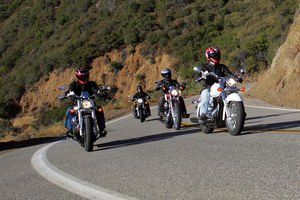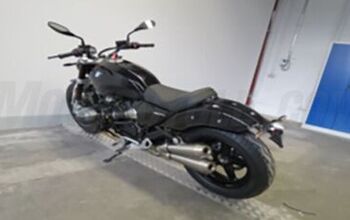2006 Light-Middleweight Cruiser Comparison - Motorcycle.com
Bigger is better, right? When you're talking cruisers, you bet it is. In the last ten years, we've seen enormous growth not only in the size of the US cruiser market, but also the size of the cruisers themselves. Where an 1100cc machine was considered big in 1995, it's now dwarfed by 800-pound, 1800, 2000 and even 2300cc behemoths. And don't get us started on the two-wheeled muscle car that is the Boss Hoss.
Even the "middleweight" category is getting bigger, not unlike the very consumers they are being sold to. Those of you who suffered through Gabe's V-Star 1300 introduction report may have been as scandalized as he was to find that a bike with a 1.3-liter engine -- the same size as a Geo Metro or Mazda Miata -- is a "middleweight" cruiser, according to Yamaha. Logically, then, the Kawasaki Vulcan 1400, the Suzuki M90 (which is 1,474cc) and Honda's VTX1300 are all middleweights as well. These are machines with heft.
What's also big on them is price. To get big-cruiser power and feel from a heavy middleweight, be prepared to cramp your fingers writing five-figured (or close to it) checks. For entry-level and other economy-minded folks, that price of admission can be daunting. How to get onto a bike bigger and more comfortable than an entry-level machine without taking out a second mortgage?
Fortunately, the Japanese factories feel your pain and want your business, with a selection of light-middleweight cruisers offered at prices less than half of what they charge for their flagship (or do we call them "heavy heavyweight"?) machines. We got on the MO OEM hotline phone -- with its power to instantly summon, genie-like, whatever motorcycle we'd like to test* -- and had Honda, Kawasaki and Suzuki send over their light-middleweight offerings like rare sweetmeats at an imperial banquet.
Honda's emissary is their venerable 750 Shadow Aero. The Suzuki is the cryptically-named M50, and Kawasaki is represented by a newcomer, the Vulcan 900 Classic. Harley sent over a Sportster 883 Custom because The Maven likes them and if the 883 isn't a light middleweight, nothing is. How do they measure up?
The Contest
To test a motorcycle, you should use it as its prospective customer will use it. For a light-middleweight cruiser, that means plenty of commuting, short freeway hops, moderately-paced jaunts on country roads and boulevard profiling. Since we are but three MOrons and we had four bikes, we placed a call to Will "Will" Tate, an old friend of MO who has helped with a few tests and knows cruisers, as he's also Victory's fleet manager (and there's no conflict here... Victory doesn't compete in this price segment). We mapped out a few hundred miles of twisty blacktop around the El Lay area, spent some time commuting on the bikes, strapped them to the dyno, and then started testing. After we'd ridden and worked out the cramps and backaches caused by sitting on our tailbones with little suspension travel or rebound damping for two days, we tallied our votes and tabulated the results.
Meet the Testers
Will Tate,
Guest Tester
Age: Many, many moons.
Height: Greater than Great Bear seeking honey.
Inseam: higher than the sapling in the spring.
Favorite Fried Food: Arby's Jalapeno Bites® with Bronco Berry Sauce®
Will Tate has been a prominent figure in the life of MO, running the fleet center for some of our favorite brands of motorcycles and being incredibly patient and flexible. He's also an enthusiastic cruiser and sportbike rider, with the amazing ability to somehow turn back time and ride on the racetrack like a 14-year old.
Gabe Ets-Hokin,
Senior Editor
Age: 37
Height: Not Much
Inseam: 30"
Favorite Fried Food: tempura-battered copy of Heidigger's Being and Time with Best Foods mayonnaise
As Gabe's sense of free will and identity are mulched by the grinding MO work environment and his weight continues to increase due to his diminishing self-esteem, he finds it more difficult to enjoy riding sportbikes. That means the comfy seating and enforced mellowness of cruiser riding is increasingly attractive to The Hairy One, prompting him to investigate making MO all-cruiser and moving to Phoenix.
Pete Brissette, Managing Editor
Age: 36
Height: 5'8"
Inseam: 30"
Favorite Fried Food: Two-way tie: Jalapeno poppers or cheese sticks
If you think you've put a lot of hours in on a motorcycle, multiply that by infinity and add 30 miles, and you'll be close to the miles Pete's packed in on two wheels. Former motorcycle messenger, current teamster-in-waiting and expecting a baby next year, Pete adds his flowering talent as scribe and motorcycle tester to discern what is the best bike in the test. Plus he gets us lunch.
Alfonse "Fonzie" Palaima, Executive Editor
Age: 37
Height: 5'10"
Inseam: 33"
Favorite Fried Food: Tums (saves the waiting)
A secretly-funded government experiment involving Banquet-brand frozen meals and a trained harbor seal in the early 1970s resulted in Fonzie, our hard-charging, hard-riding, hard-headed and magnificently grumpy executive scribe, bottle washer, clock-cleaner and wagon-fixer. He loves Harley-Davidsons but sometimes has an odd way of showing it, not that there is anything wrong with unconventional expressions of love.
Tied for Third: 2007 Harley Davidson Sportster 883 Custom
$7,795 ($8,545 as tested)
The Sad Story of Little Richard
If only it were that simple. We all liked the Sportster a lot, but like all of you, we have a lot of choices. Let's look closer at the Sporty.
Its heart is the venerable air-cooled, 883cc pushrod-actuated made-in-USA V-twin. For 2007 it boasts fuel injection, and we were quite taken with how smooth-running and torquey it was. "It feels old but works great" said Will Tate, and we could swear that's what Mrs. Tate said, but we digress. Gabe agreed; "I wasn't expecting the least-expensive Harley-Davidson engine to work so well." It starts and runs smoothly, and while it isn't the powerhouse of the group it's not the slowest, either, able to hold its own on the freeway or twisty roads without too much annoying vibration, thanks to the rubber engine mounts that the Motor Company has been using since 2004. The gearbox is good as well, "surprisingly smooth", according to Pete, "with just enough `thunk' and `thud' to let the rider know it's in gear."
The chassis isn't exactly ground-breaking, but it represents a huge leap forward for Sportster-kind. In 2004, the motor was rubber-mounted, the frame was made heavier, and although the Sportster now weighed in a 564 pounds dry (claimed), it was now much smoother, better-handling, and more pleasant to ride. The rubber mounts allow the rider to rev the engine and really enjoy it, and the traditional look of the Sporty remains; twin shocks, small tank (although it has been enlarged to 4.5 gallons) and small, hooded headlamp.
Comfort is a mixed bag. The seat is low and the reach to the bars is rational. The seat is low enough that Al told Gabe it made him look taller, which prompted Gabe to award the Harley 50 brownie points. However, Gabe found that seat "horrible"; hard and lacking room to move around on. There's also a powerful wind blast at freeway speeds, although the tall gearing (at least in this company, although it's short compared to the 1200 Sportster) means it also feels the "least busy" on the freeway, according to Gabe.
The handling was not bad, although it was limited by a few things. It steers easily and "surprisingly" holds its line the best at high speeds, according to Will, and it has the most cornering clearance here. Unfortunately, that's not saying much in this company, and when the Sporty does touch down, it's the all-too-solidly-mounted exhaust pipes, which Will says can be "downright scary" when they drag. Aside from that, Pete found the "chassis provides good stability for virtually all situations", and Gabe is "still impressed by the new Sportster's chassis."
The brakes also reward a moderate pace. Will noted "numb feel" from the single disc, and although Pete conceded the brakes "offer enough stopping power, considering how most people will use the bike", when pushed the brakes "fade substantially and their limits are quickly found". Gabe noted a "wooden feel and high effort" as well. Would it be a good idea to have powerful, dual-disc brakes on a skinny front tire?
Perhaps it wasn't fair to pick the most-expensive Custom for this test, but we wanted something with a little more flavor than the bare-bones 883. The look, sound and classy heritage are all here in spades, and that counts for a lot. However, in functional terms, the 883 Custom couldn't compete with the more practical bikes here. We'd recommend looking at the basic 883 or the 883R for a nicely-priced, good-functioning Harley.
More by MO Staff








































Comments
Join the conversation